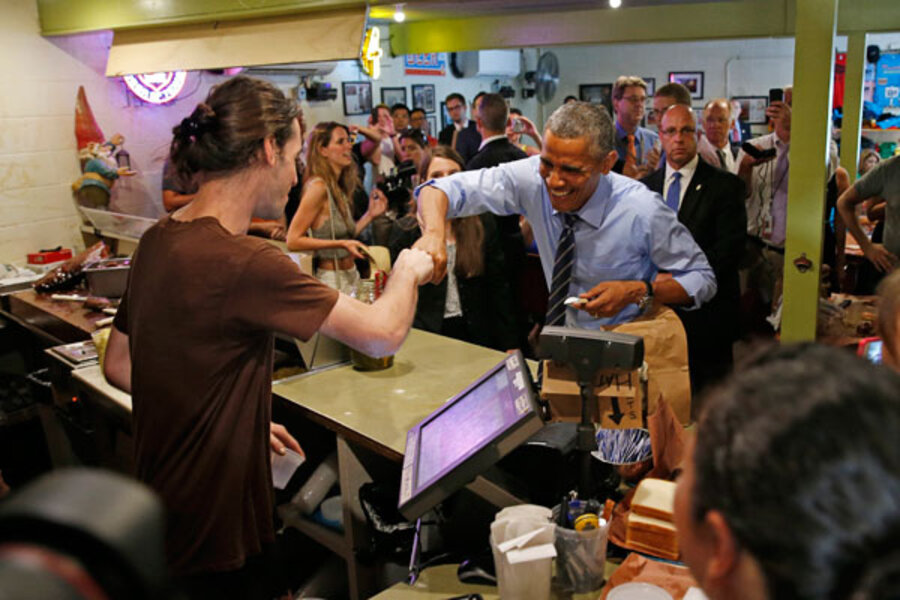Obama's no-win situation on border crisis
Loading...
| Washington
Was President Obama “tone deaf” for not visiting the US-Mexico border while in Texas to do some fundraising this week?
Republicans, and even some Democrats, are heaping criticism on the president for avoiding that photo op, amid a surge of undocumented children entering the United States from Central America. The crisis threatens to be Mr. Obama’s “Katrina moment,” they say, referring to President George W. Bush’s botched handling of the hurricane that devastated the Gulf Coast in 2005.
On Thursday, a more recent analogy came up: superstorm Sandy, which hit the East Coast in 2012.
"The American people expect to see their president when there is a disaster," Gov. Rick Perry (R) of Texas told CNN. "He showed up at Sandy. Why not Texas?"
Of course, neither storm is really analogous to the child migrant crisis, which has been building for years and turned into a flood in recent months. But in a general sense, the comparison seems to work. By not visiting the border, Obama’s critics can say he doesn’t care enough to see for himself what’s happening.
After all, the argument goes, he does photo ops all the time – and not just following storms. He visited California’s Central Valley in February to view the cracked earth amid a crippling drought. Early in his presidency, he let the cameras roll when he held a “beer summit” in the Rose Garden after a racially charged incident involving a black academic and white police officer.
But in this case, Obama said Wednesday, "I'm not interested in photo ops, I'm interested in solving the problem.”
"There is nothing taking place down there that I am not intimately aware of and briefed on," he added, pointing out that his secretary of Homeland Security, Jeh Johnson, is about to visit the border for the sixth time.
Ultimately, it seems, Obama can’t win.
“If Obama had been willing to go with Perry to the border, that would have been the optics Perry was looking for – where he could lecture the president, with people crossing the Rio Grande in the background,” says Cal Jillson, a political scientist at Southern Methodist University in Dallas. The compromise plan – Obama and Perry meeting in Dallas – was “much more controllable.”
The fact that Governor Perry is considering another run for president added a political dimension that Obama apparently did not want to play into.
But Obama wasn’t able to escape awkward optics on the trip. On Tuesday night in Denver, he shot pool and had beer with the governor of Colorado, John Hickenlooper (D) – in addition to sharing pizza with a group of people who had written to him.
It was the day before Obama went to Texas, but it was all part of the same trip – and produced a photo of the president having fun. That, combined with Obama’s multiple visits to Democratic fundraisers in both Denver and Dallas, made for one big ball of awkward.
Another option in Texas might have been for the president to visit a holding pen of child migrants, but that too might have been a risky photo op. At the very least, it would likely have been a heart-rending picture. Obama could have been accused of trying to build sympathy for the children. The White House has asserted that “most” will be deported.
Beyond optics, the crisis itself has put the president in a major bind. Republicans in Congress are balking at his request for $3.7 billion in supplemental spending to help care for the children and speed up deportation proceedings. GOP leaders say they’re reluctant to give the administration a “blank check” without more detail on how that money would stem the border crisis.
Republicans also want changes to a Bush-era law aimed at combating child trafficking that makes it harder to deport undocumented children from Central America quickly. Some Democrats and immigrant-rights groups defend the law as a necessary protection to exploited children.
But on Thursday, House minority leader Nancy Pelosi (R) said Democrats were prepared to accept some changes to the law. “I don’t think it should be a priority … but it’s not a deal-breaker,” Congresswoman Pelosi told reporters in the Capitol, according to The Hill newspaper.
The concerns of key elements of the Democratic base – Latinos and other pro-immigrant groups – add another political dimension to the border crisis. If those groups feel the administration is too hard on the children, those constituencies may be discouraged from voting in the November midterms. The Democrats are fighting hard to keep their majority in the Senate and are working to boost turnout.
Since last October, more than 52,000 unaccompanied children, plus 39,000 women and children, have entered the US illegally via Mexico. Altogether, the influx has overwhelmed US border facilities, particularly at the Rio Grande Valley Sector of the US border patrol.






